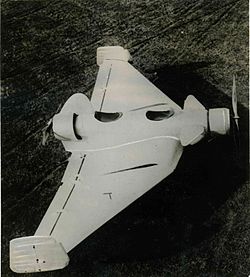Fieseler F 3
| Fieseler F 3 "Wasp" | |
|---|---|
 The F 3 'Wasp' at the Kassel-Waldau airfield |
|
| Type: | Sports and touring aircraft |
| Design country: | |
| Manufacturer: | |
| First flight: |
May 1932 |
| Commissioning: |
1932 |
| Production time: |
1931/32 |
| Number of pieces: |
1 (2 unfinished) |
The Fieseler F 3 "Wasp" was a two-seat, tailless motorized airplane in a delta shape with two engines in tandem. The construction was carried out by Alexander Lippisch from the Rhön-Rossitten-Gesellschaft (RRG), the construction of three machines was carried out by Fieseler Flugzeugbau . Test flights showed that this aircraft could not be piloted, so the project was discontinued.
history
The cigarette company Haus Bergmann in Dresden planned to use three two-seater powered aircraft for the European sightseeing flight in 1932, which should be particularly striking in terms of appearance and performance. They wanted to use this as an effective advertising medium and asked Fieseler Flugzeugbau in Kassel. Gerhard Fieseler's idea was to develop a sports and touring aircraft in a delta shape that was unusual for the time, which was to have two engines in tandem as a special safety feature. So he got in touch with the RRG on the Wasserkuppe. There, the chief designer Alexander Lippisch had already successfully developed gliders and powered aircraft as flying wings . The RRG agreed to construct such an aircraft and bring it to acceptance by the German Aviation Research Institute (DVL). The scope of work at Fieseler Flugzeugbau included the manufacture and flight of the machine. The cigarette company agreed with Fieseler's proposal and gave him the order for three of these aircraft.
construction

The RRG began developing this type of aircraft under the name “Delta IV” in the winter of 1931/32; in the Fieseler Flugzeugbau it was named F 3 "Wasp". The result was a machine with a trapezoidal structure . The ailerons and elevators formed the trailing edge of the wings in one line. Two rudders were arranged as end disks at the wing tips. According to the competition announcement, the wings also had to be foldable.
In the fuselage, the two engines were attached to the bow and stern, one propeller each ran in pulling and pushing mode. When choosing the engines, the British 7-cylinder radial engine “ Pobjoy R ” was chosen . The two seats were arranged one behind the other between the drives. The chassis consisted of two wheels at the front and a movable spur at the rear. Since Fieseler was convinced of the expertise of RRG for this order, he immediately put on a series of three. Thanks to the good cooperation between designers and aircraft manufacturers, the first machine was ready for its maiden flight at Kassel-Waldau airfield in May 1932 .
Flight characteristics
Gerhard Fieseler was also the test pilot of his company at the time. After attempting to taxi, the aircraft broke when the aircraft took off for the first time due to an uncontrollable flight movement around the transverse axis . Fieseler stopped work on the two other machines. After the repairs and structural changes by the RRG, Fieseler tried to get the F 3 into the air. Even two more breaks on the ground didn't stop him from doing this. In the meantime, an additional duck wing had been added in front of the main wing and the landing gear arrangement and tail units had been changed. Now Fieseler have reached the first laps by using all his flying skills. He came to the conclusion that the flight characteristics could not be improved any further. From his point of view, this aircraft could not be controlled by a "normal pilot". In order to get a statement from a neutral point, he asked the DVL to fly the machine. Before this happened, Fieseler had a double tax installed. He agreed with the DVL pilot Hans-Dietrich Knoetzsch that he should start the F 3 and bring it to a safe flight altitude in order to then hand over the helm. Knoetzsch tested the machine and then refused to issue an airworthiness declaration. Fieseler then ended the project.
Whereabouts
A generous agreement was reached with the cigarette company as the client. There was a legal dispute with a subsequent settlement between RRG and Fieseler. This stipulated that the trial machine would go to RRG at a moderate price and that Fieseler would have to bear the costs of all changes and repairs for the two other machines. At RRG, the acquired Delta IV was completely redesigned; this resulted in the DFS 39 , a two-seater single-engine sport aircraft.
Technical specifications
| Parameter | Data |
|---|---|
| crew | 1 |
| Passengers | 1 |
| length | 4.54 m |
| span | 8.70 m |
| height | 1.75 m |
| Wing area | 16.40 m² |
| Takeoff mass | 680 kg |
| Top speed | 250 km / h |
| Engine | 2 × Pobjoy R, 75 PS (55 kW); air-cooled 7-cylinder radial engine |
See also
literature
- Gerhard Fieseler: My path in the sky. The builder of the Fieseler Storch and the V 1 tells his life . Bertelsmann Verlag, Munich 1979, ISBN 3-570-01192-5 (autobiography).
- Fieseler magazine. Born 1938, ZDB -ID 1293906-7 .
- Technical data from documents from Fieseler Flugzeugbau Kassel
Web links
- Günter Frost: FieselerF 3 "Wasp" (RRG "Delta IV"). 2013, accessed March 26, 2020 .